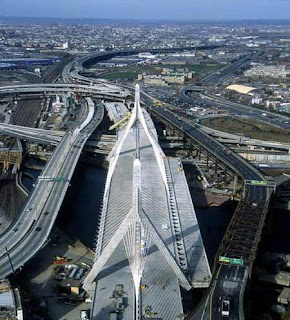From Oversimplification To Rube Goldberg
On the one hand, there is a wide spectrum of complexity of construction ranging from doing nothing to Rube Goldberg level complexity. On the other hand, there is the set of solutions that work, meaning that they meet all of the requirements. TSTTCPW refers to the solution which works and which is lowest in complexity.
Part of being simple means simple to read, maintain, use, design, understand, and implement balanced against the time it takes to get the job done. Spending too much time to create the ultimate in simplicity starts to get you into a different kind of trouble.
As somebody that struggles to apply this principle on a regular basis, I was happy to stumble upon an example of this principle which can be captured in a picture and kept in mind as I am working on a new design. Perhaps you will find it to be useful food for thought as well.
A Bridge Too Far

There’s a construction project that you’ve probably heard of which is affectionately called the “Big Dig.” Part of this project was the construction of the “Leonard P. Zakim Bunker Hill Bridge” aka the “Zakim bridge.” This part suspension bridge, part cantilever bridge is an enormous one of a kind architectural marvel. It supports five lanes of traffic in either direction for a total of ten lanes. It was built at a cost of approximately $11M per lane.
Running parallel to the Zakim (to the left in the photo) is the Leverett Circle Connector Bridge. It serves a total of four lanes of traffic. It was built at a cost of approximately $5M per lane.
Part of the requirements for the Zakim bridge were clearly “create a stunning new Boston landmark.” On the other hand, the Leverett Bridge is a very simple but also very strong bridge. It could have been made even more simply, but not without a safety risk and/or a shorter lifespan. In other words, it is “The Simplest Thing That Could Possibly Work.”
Next: The Faberge Egg
TOC: Zero to Hyper Agile in 90 Days or Less
[Note: revised 7/3/08 to reflect comments on reddit. Clearly the original post didn't work. :) ]
2 comments:
I like simplification and simple things... Who doesn't? If it makes my life easier and satisfies the customer I am all for it. On the other hand I have a problem with the way Agile methodologies are implemented by the late comers to the idea, the big Enterprises. Agile becomes a rigid dogma (The Agile 800 Pounds Gorilla) and the simplification principle is used to push half cooked solutions for the sake of satisfying tight deadlines. It might work in short term but for long term projects it is a sure way to get fast to architectural disintegration.
Now if it were only that simple to make a few edits to the Big Dig in Boston. :-) I love it when the comments (from Reddit) are just as educational as the original post. Good stuff.
Post a Comment